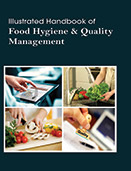Hotel and Restaurant Management

Food safety is a growing global concern not only because of its continuing importance for public health but also because of its impact on international trade. Quality management plays a vital role within the food industry, across many different stages of sourcing, processing and packaging. In addition to basic laws and regulations on nutritive value, quality levels also incorporate factors such as shelf-life, raw materials, taste, texture, use of preservatives and many other indicators too. This means that food manufacturing practice and sanitation are two of the most important factors in preventing foodborne diseases and in providing safe foods. Not surprisingly, this makes it all the more important for food manufacturers to adhere to an efficient quality management system (QMS) in order to achieve standardization and meet the demands of consumers and authorities.
Illustrated Handbook of Food Hygiene & Quality Management provides students with an insight into measures that are required to provide a supply of safe and wholesome food to consumers globally. A wide spectrum of food safety and quality management issues are addressed. Each of these aims exists to a greater or lesser extent in all food production, but the processing of a given product may emphasize some more than others. For example, frozen vegetables are intended to have sensory and nutritional qualities that are as close as possible to the fresh product, but with a shelf life of several months instead of a few days or weeks. The main purpose of freezing is therefore to preserve the food. In contrast, sugar, confectionary, and snack foods are intended to provide variety in the diet. A large number of shapes, flavors, colors, and textures are produced from basic raw materials. Reducing the severity of processing, and consequently decreasing the losses of some nutrients, is one of the trends in modern food technology. However, a less intensive heat treatment may increase the risk of microbial contamination. The risks arising from less severe processing may be reduced by deeper knowledge of the impact of processing on food components and on microorganisms.
This Illustrated Handbook of Food Hygiene & Quality Management is a must-have for students and food industry professionals active in various areas of food production systems. The integrated approach with technological and managerial principles and practices for analyzing food quality management, and valuable information on the latest developments make this book of great importance.
It will guide you through a comprehensive exploration of the issues involved, from regulatory processes to the role of public institutions and policy makers.